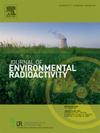A protocol for the radiological assessment for agricultural use of land in Ukraine abandoned after the Chornobyl accident
IF 2.1
3区 环境科学与生态学
Q3 ENVIRONMENTAL SCIENCES
引用次数: 0
Abstract
There is a need in Ukraine for re-evaluation of the status of lands outside the Chornobyl Exclusion Zone which were abandoned in the years after the accident. Since the 1991 criteria for zoning were put in place, there has been no re-classification of abandoned lands even though radionuclide contamination density and, for radiocaesium isotopes, mobility have both declined. This study describes the development of a protocol for assessment of abandoned lands in Ukraine based on a 100 ha experimental plot. A simple method of quantification of 137Cs contamination density was developed using external dose measurement whilst other relevant radionuclides (90Sr; 241Am and Pu isotopes) were quantified using selected soil samples. Modelling of uptake of radionuclides in eight key crops shows that the study field could be re-used for agriculture according to Ukrainian regulatory limits. Monte Carlo modelling of potential dose to farm workers showed that dose was dominated by external exposure and that doses were significantly below 1 mSv y−1. Based on statistical analysis of soil-plant concentrations ratios, criteria were derived for assessment of suitability of agricultural land for production. The criteria are applicable to areas of soddy-podzolic sandy and sandy loam soils (Podzoluvisol) typical in these regions of Northern Ukraine. They are not applicable to high organic matter soils (Histosols) where soil-plant concentration ratios are likely to be much higher for radiocaesium.
一项关于乌克兰农业用地放射性评估的议定书在切尔诺贝利事故后被废弃
在乌克兰,有必要重新评估切尔诺贝利禁区以外的土地的状况,这些土地在事故发生后的几年中被遗弃。自从1991年制定分区标准以来,即使放射性核素污染密度和放射性铯同位素的流动性都有所下降,也没有对废弃土地进行重新分类。本研究描述了基于100公顷试验田的乌克兰废弃土地评估方案的发展。建立了一种简单的定量137Cs污染密度的方法,使用外剂量测量,而其他相关放射性核素(90Sr;利用选定的土壤样品定量分析了am和Pu同位素。8种主要作物对放射性核素吸收的模拟表明,根据乌克兰的监管限制,该研究领域可以重新用于农业。对农场工人的潜在剂量进行蒙特卡罗模拟表明,剂量主要是由外部照射决定的,剂量明显低于1毫西弗y - 1。基于土壤-植物浓度比的统计分析,导出了农业用地适宜性评价标准。该标准适用于乌克兰北部这些地区典型的灰化土和砂壤土(灰化土)。它们不适用于高有机质土壤(组织土壤),因为土壤-植物的放射性铯浓度比可能要高得多。
本文章由计算机程序翻译,如有差异,请以英文原文为准。
求助全文
约1分钟内获得全文
求助全文
来源期刊

Journal of environmental radioactivity
环境科学-环境科学
CiteScore
4.70
自引率
13.00%
发文量
209
审稿时长
73 days
期刊介绍:
The Journal of Environmental Radioactivity provides a coherent international forum for publication of original research or review papers on any aspect of the occurrence of radioactivity in natural systems.
Relevant subject areas range from applications of environmental radionuclides as mechanistic or timescale tracers of natural processes to assessments of the radioecological or radiological effects of ambient radioactivity. Papers deal with naturally occurring nuclides or with those created and released by man through nuclear weapons manufacture and testing, energy production, fuel-cycle technology, etc. Reports on radioactivity in the oceans, sediments, rivers, lakes, groundwaters, soils, atmosphere and all divisions of the biosphere are welcomed, but these should not simply be of a monitoring nature unless the data are particularly innovative.
 求助内容:
求助内容: 应助结果提醒方式:
应助结果提醒方式:


